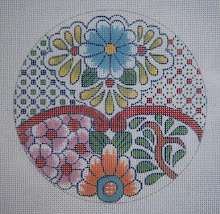 I was looking through old picture files yesterday, hoping to find inspiration - and I did! I won't show the photo, as it's been so long, I don't remember who did the work. It's a block from an art crazy quilt that has four layers of shades of pink, embellished with embroidered seam treatments - which goes right along with what I'm doing these days in needlepoint.
I was looking through old picture files yesterday, hoping to find inspiration - and I did! I won't show the photo, as it's been so long, I don't remember who did the work. It's a block from an art crazy quilt that has four layers of shades of pink, embellished with embroidered seam treatments - which goes right along with what I'm doing these days in needlepoint. As for the layers of shades of color, I decided it would be fine to do an ornament, but with needle blending, as Anne Stradal (The Cape Stitcher) taught me. She uses this technique for skies behind lighthouses and California missions. Charming!! I used it on my recent "Coral Reef" series to shade the sea water from light at the top to dark at the bottom of the ocean.
The first scan is one of the water droplets, where you can see the gradual shading from top to bottom. This is achieved (on 18 mesh canvas) by dividing the piece into equi-distant sections, using five if you're just using two shades of a color - which is quite enough!
Start on the first section with four plies of the lightest color. Then on the next one, three plies of the light, plus one of the dark. Next - two of each, then three of the dark and one light, and finish with four plies of the dark. Very easy! (using DMC cotton floss)
 I worked on the red one first, but decided to make it larger for the pink one and use three shades of the pink. Be sure not to have the shades of color too far apart in value.
I worked on the red one first, but decided to make it larger for the pink one and use three shades of the pink. Be sure not to have the shades of color too far apart in value. By using three shades, I had to use more divisions - and arrived at 8, so the little spaces are narrower. Also, I drew the ornament larger than the red one, which is from my collection of "traditional ornament shapes." (Available as E-Patterns on my web page.)
The ornament that is to be red is 4 1/8" wide. If you print this out, you may either just trace it onto canvas, or - better - go ahead and stitch draw it, following my drawing, as it's very easy - and much better to have it perfectly symmetric. On this one, I'm using Nobuko stitch for background.
The ornament that is to be shades of pink is 5" wide. By no means does it have to be divided into 8 segments for three shades - could also be worked beautifully with just the two shades on five segments. I had originally drawn these to do more of the Coral Reef things - using different shapes and salt water tropical fish. Will do that another time!!
ADDENDUM: It's Monday morning, and my mind seems to be coming back - I remembered where I saw the beautiful crazy quilt block which inspired the "layered" pink ornament! It was on the blog by Jo of New Zealand - No Matter Where I Go, I Always Meet Myself There - this is fun, informative, and very imaginative, as well as showing beautiful needlework.










